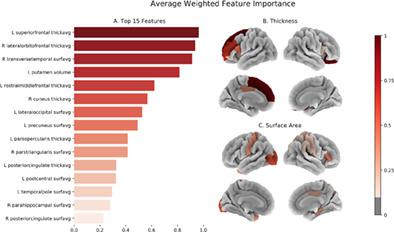当前位置:
X-MOL 学术
›
Hum. Brain Mapp.
›
论文详情
Our official English website, www.x-mol.net, welcomes your
feedback! (Note: you will need to create a separate account there.)
Predicting alcohol dependence from multi-site brain structural measures
Human Brain Mapping ( IF 3.5 ) Pub Date : 2020-10-16 , DOI: 10.1002/hbm.25248 Sage Hahn 1 , Scott Mackey 1 , Janna Cousijn 2 , John J Foxe 3 , Andreas Heinz 4 , Robert Hester 5 , Kent Hutchinson 6 , Falk Kiefer 7 , Ozlem Korucuoglu 8 , Tristram Lett 4 , Chiang-Shan R Li 9 , Edythe London 10 , Valentina Lorenzetti 11, 12, 13 , Luijten Maartje 14 , Reza Momenan 15 , Catherine Orr 1 , Martin Paulus 16, 17 , Lianne Schmaal 18, 19 , Rajita Sinha 9 , Zsuzsika Sjoerds 20, 21 , Dan J Stein 22 , Elliot Stein 23 , Ruth J van Holst 24 , Dick Veltman 25 , Henrik Walter 4 , Reinout W Wiers 2 , Murat Yucel 10, 26 , Paul M Thompson 27 , Patricia Conrod 28 , Nicholas Allgaier 1 , Hugh Garavan 1
Human Brain Mapping ( IF 3.5 ) Pub Date : 2020-10-16 , DOI: 10.1002/hbm.25248 Sage Hahn 1 , Scott Mackey 1 , Janna Cousijn 2 , John J Foxe 3 , Andreas Heinz 4 , Robert Hester 5 , Kent Hutchinson 6 , Falk Kiefer 7 , Ozlem Korucuoglu 8 , Tristram Lett 4 , Chiang-Shan R Li 9 , Edythe London 10 , Valentina Lorenzetti 11, 12, 13 , Luijten Maartje 14 , Reza Momenan 15 , Catherine Orr 1 , Martin Paulus 16, 17 , Lianne Schmaal 18, 19 , Rajita Sinha 9 , Zsuzsika Sjoerds 20, 21 , Dan J Stein 22 , Elliot Stein 23 , Ruth J van Holst 24 , Dick Veltman 25 , Henrik Walter 4 , Reinout W Wiers 2 , Murat Yucel 10, 26 , Paul M Thompson 27 , Patricia Conrod 28 , Nicholas Allgaier 1 , Hugh Garavan 1
Affiliation

|
To identify neuroimaging biomarkers of alcohol dependence (AD) from structural magnetic resonance imaging, it may be useful to develop classification models that are explicitly generalizable to unseen sites and populations. This problem was explored in a mega-analysis of previously published datasets from 2,034 AD and comparison participants spanning 27 sites curated by the ENIGMA Addiction Working Group. Data were grouped into a training set used for internal validation including 1,652 participants (692 AD, 24 sites), and a test set used for external validation with 382 participants (146 AD, 3 sites). An exploratory data analysis was first conducted, followed by an evolutionary search based feature selection to site generalizable and high performing subsets of brain measurements. Exploratory data analysis revealed that inclusion of case- and control-only sites led to the inadvertent learning of site-effects. Cross validation methods that do not properly account for site can drastically overestimate results. Evolutionary-based feature selection leveraging leave-one-site-out cross-validation, to combat unintentional learning, identified cortical thickness in the left superior frontal gyrus and right lateral orbitofrontal cortex, cortical surface area in the right transverse temporal gyrus, and left putamen volume as final features. Ridge regression restricted to these features yielded a test-set area under the receiver operating characteristic curve of 0.768. These findings evaluate strategies for handling multi-site data with varied underlying class distributions and identify potential biomarkers for individuals with current AD.
中文翻译:

从多部位大脑结构测量预测酒精依赖
为了从结构磁共振成像中识别酒精依赖 (AD) 的神经成像生物标志物,开发可明确推广到看不见的部位和人群的分类模型可能很有用。在对来自 2,034 AD 和比较参与者的大型分析中探索了这个问题,这些数据集跨越了由 ENIGMA 成瘾工作组策划的 27 个站点。数据分为用于内部验证的训练集,包括 1,652 名参与者(692 AD,24 个站点),以及用于外部验证的测试集,包括 382 名参与者(146 AD,3 个站点)。首先进行了探索性数据分析,然后是基于进化搜索的特征选择,以站点可概括和高性能的大脑测量子集。探索性数据分析表明,仅包含病例和对照站点会导致无意中了解站点效应。不能正确考虑站点的交叉验证方法可能会大大高估结果。基于进化的特征选择利用leave-one-site-out交叉验证来对抗无意学习,确定了左侧额上回和右侧眶额皮质的皮质厚度、右侧颞横回和左壳核的皮质表面积体积作为最终特征。仅限于这些特征的岭回归在 0.768 的接收器操作特征曲线下产生了一个测试集区域。
更新日期:2020-10-16
中文翻译:

从多部位大脑结构测量预测酒精依赖
为了从结构磁共振成像中识别酒精依赖 (AD) 的神经成像生物标志物,开发可明确推广到看不见的部位和人群的分类模型可能很有用。在对来自 2,034 AD 和比较参与者的大型分析中探索了这个问题,这些数据集跨越了由 ENIGMA 成瘾工作组策划的 27 个站点。数据分为用于内部验证的训练集,包括 1,652 名参与者(692 AD,24 个站点),以及用于外部验证的测试集,包括 382 名参与者(146 AD,3 个站点)。首先进行了探索性数据分析,然后是基于进化搜索的特征选择,以站点可概括和高性能的大脑测量子集。探索性数据分析表明,仅包含病例和对照站点会导致无意中了解站点效应。不能正确考虑站点的交叉验证方法可能会大大高估结果。基于进化的特征选择利用leave-one-site-out交叉验证来对抗无意学习,确定了左侧额上回和右侧眶额皮质的皮质厚度、右侧颞横回和左壳核的皮质表面积体积作为最终特征。仅限于这些特征的岭回归在 0.768 的接收器操作特征曲线下产生了一个测试集区域。











































 京公网安备 11010802027423号
京公网安备 11010802027423号